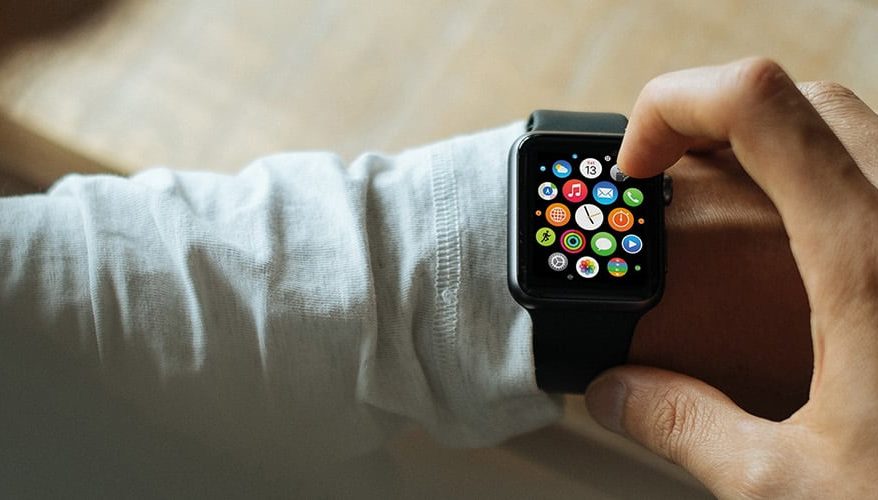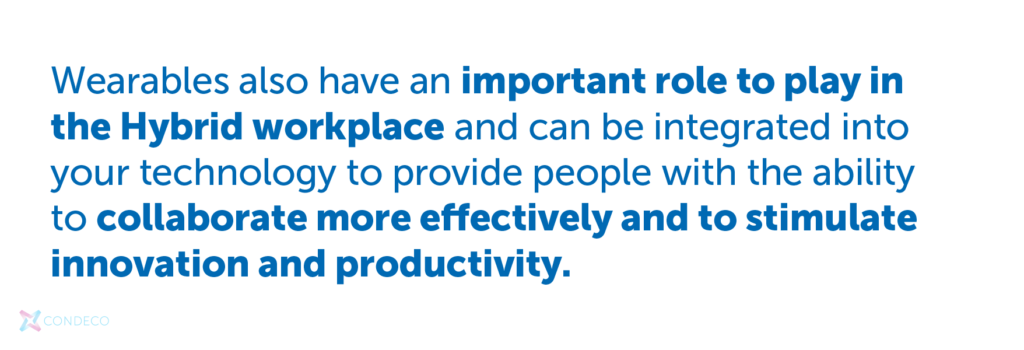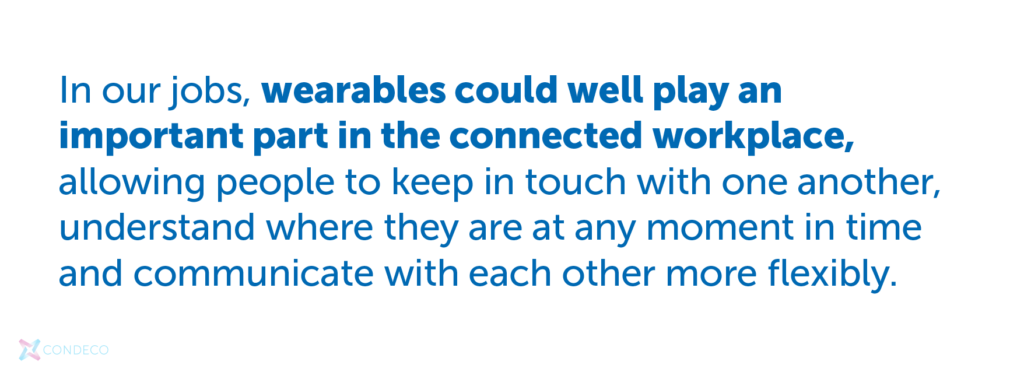
Wearable technology may seem to be a recent development – think of the fictional spy gadgets of James Bond, or the smartwatches that are currently flooding the market. Despite this, wearable tech has been around for longer than we might think and is helping to shape the future of our lives.

Wearables also have an important role to play in the Hybrid workplace and can be integrated into your technology to provide people with the ability to collaborate more effectively and to stimulate innovation and productivity. The solutions to your flexible work challenges could well be found around someone’s wrist.
What is wearable technology?
Wearable technology (commonly called wearables) covers electronic devices that are worn close to the skin, on clothes or even as implants or tattoos. They have most popularly been used as a way of monitoring health, providing real time data on, for example, heart rate or number of steps taken that day. However, they can now also be used to receive emails, make phone calls or set alarms. In fact the number of functions they provide is growing all the time.
Examples of wearable technology
Many people associate wearable technology with smart watches. However, they can come in all shapes and sizes, including
- Smart jewellery – such as rings or earrings
- Hearables – earphones that can do much more than play music
- Smart clothing – for example sneakers that can monitor your daily run
- Wearable cameras – that attach to your head or parts of your clothing
- Fitness trackers – already hugely popular, providing motivation for millions to get healthy
- Smart glasses – spectacles that deliver VR, AI, communications and other real time feedback
- Implantables – did you know pills have already been created that offer health monitoring from within the body?
When was wearable technology invented?
It could be argued that wearable technology goes back a long way, at least to the invention of glasses around 800 years ago. The wristwatch is another obvious example of an early wearable technology as large clocks were refined into something people could take with them everywhere. However, in the age of computers, wearable technology started its modern journey in the 1950s, only a few years after computer technology itself became established.
Wearable technology history timeline
1950s
Radio days
Wearable tech began very differently from today’s recognizable devices, with Sony’s first transistor radio making its debut in 1955.
“The Sony TR-55 served as the template for portable gadgets we use today. Everything from the iPod to the Game Boy can trace its basic handheld design to the TR-55’s form factor.”- Wired Magazine
Virtually reality
Sometimes the seemingly most advanced tech gets invented before the simpler devices. Morton Helig created the Telesphere Mask, the first head-mounted display that offered film in 3D and stereo sound to the user. It would take some years but the VR headset would eventually emerge from this early breakthrough.
1960’s
Taking a gamble
In 1961, Edward Thorp and Claude Shannon created their own version of wearable technology – a computer small enough to fit into a shoe. Designed to help them cheat at a game of roulette, the computer was a timing device to predict where the ball would land.
1970’s
It all adds up
Wearable tech went mainstream in 1975, as the first calculator wristwatch was released. Worn by Sting on the cover of The Police’s Wrapped Around Your Finger, and by Marty McFly in Back to the Future, it became an icon of the ‘70s and ‘80s.
Back then a watch could cost well over $3,000 in today’s money. It was only when business leaders saw the commercial opportunities that the technology improved and prices came down. If you’re old enough to remember the 1980s then it’s highly likely that the calculator wristwatch you wore was made by Casio.
Far sighted
Wearables didn’t move forward too much in the 1970s although the technology that would make them so prominent was beginning to be developed. For a precursor of the GoPro we could look at the invention of the first head mounted camera that was designed for the blind to create vibrations on a vest, providing information about immediate surroundings.
1980’s
Wired for sound
The Walkman, launched in 1979, became our go-to music device throughout the 1980s. A revolution in music and wearable technology, the Walkman was so popular it sold over 200 million units.
“Don’t you think a stereo cassette player that you can listen to while walking around is a good idea!” Sony Chairman, Akio Morita.
Good health
In 1987, digital hearing aids were released, revolutionizing the healthcare industry. The fitness tracker was also born in this decade in the form of heart monitors that were a must-have for any serious professional athlete. Like many of the devices on this list, features were gradually added until we have the products we see today that can tell you how long and fast you’ve run, how many calories you’ve burned and many other variables.
“Usage of healthcare, wellness, and medical apps is up 16% from last year to 28% of consumers. Nearly two-thirds of physicians said they would prescribe an app to manage chronic diseases like diabetes.”
1990’s
Talking pictures
In December 1994, Steve Mann, a Canadian researcher, developed the Wearable Wireless Webcam. Despite its bulk, it paved the way for future Internet of Things (IoT) technologies.
Find the way
Location tracking was also moved forward in this decade with the invention of the portabler Active Badge from Olivetti. This used infrared signals to provide someone’s location and can be seen as a precursor of apps such as Google Maps.
2000’s
Sweet music
Do you remember the promise of having ‘1000 songs in your pocket’? Wearable technology found its groove in the 2000s probably most famously with the iPod. A step forward from the Walkman, it reduced the need for clunky tapes or discs and used technology to shrink the world’s music into something anyone could use on a walk or in the gym. In many ways, this pioneering approach set the theme for the future of wearables.
Norse code
Bluetooth, named after a Viking king, was another major breakthrough in this decade, offering greater scope for wearable devices to communicate with the world and each other. The invention’s impact can be seen today as we talk to each other through Bluetooth headsets, send messages and use the technology to support connectivity and collaboration between people.
The race begins
The introduction of Fitbit in the 2010s led to the explosion of health watches and other wearables that monitor our activity, helping us set personal bests and warning us when something might be wrong. Fitbit founders James Park and Eric Friedman held a talk at the TechCrunch 50 conference in 2008 hoping to get 50 pre-orders, although expecting only 5. By 2009 more than 25,000 Fitbits were being sold.
2010s
Fragile glass
The wearable craze exploded in 2013 when Google Glass entered the market, followed by the Apple Watch in 2015, and the Oculus Rift Headset in 2016. Google Glass was considered a rare failure for the company at the time but is now seen as a pioneer for the future where everything is connected and you can gather real time information simply and on the move.
Into the metaverse
Oculus Rift itself is still very much with us as Facebook (Meta) and others plot a future Metaverse where the web becomes three dimensional and interactive. Some form of headset is likely to be the way we access this brave new world but have you worn one at a virtual meeting yet?
2020s and beyond
Wearables have now attached themselves to the lives of millions and we can only see their rise continue. As technology improves so will the functions of wearables. For example, clothing designers are experimenting with fabrics and technology, signalling that smart clothing is on its way to the mainstream. Some innovative items are already available, like the Nadi X Yoga Pants, which feature in-built haptic vibrations to encourage you to move or hold positions.
The sheer variety of wearable tech available continues to grow, as designers look for new ways to innovate and incorporate technology into all kinds of clothing and accessories. We could even see wearables in the form of tattoos.
Wearable technology and the workplace

In our jobs, wearables could well play an important part in the connected workplace, allowing people to keep in touch with one another, understand where they are at any moment in time and communicate with each other more flexibly. On the go work will be made easier by wearables and they are likely to become part of your technology mix to encourage collaboration and communicate. Imagine being able to book a meeting room with the flick of your wrist or check your calendar by touching you ear – the possibilities are endless.
In a recent survey on wearable technology, 49% of respondents believe wearable tech will increase workplace efficiency – PricewaterhouseCoopers, The Wearable Life: Connected Living in a Wearable World
More history of the office
Learn more about the history of the workplace with a retrospective guide on the evolution of our offices, and a look at what the future will hold for employees and business owners. For more on workplace tech check out our article on the history of voice recognition.



